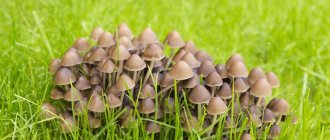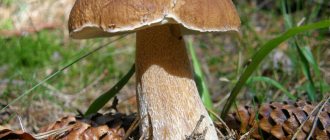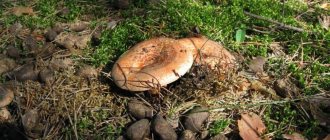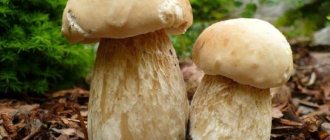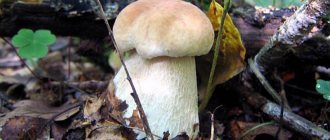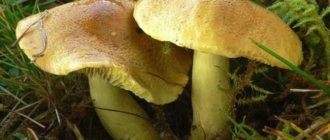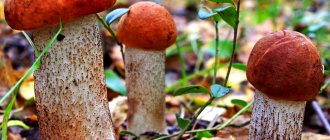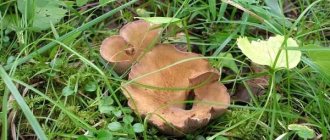This mushroom has received many different nicknames among the people: prushka, conical bald head, cheerful mushroom, cap (hat) of freedom. The international name of the mushroom is Psilocybe semilanceata. The species is cosmopolitan and is widespread in temperate and subarctic latitudes. In recent decades, this type of mushroom has been discovered in the Southern Hemisphere, in India, South America, and Australia.
Description
The mushroom cap varies from 5 to 22 millimeters in diameter and is bell-shaped. In old mushrooms, the shape becomes semi-prostrate with grooves along the edges. A distinctive feature of the mushroom is the presence of a sharp lump in the center of the cap. The skin color varies from dark brown to beige. Color can also be determined by habitat and humidity. The wetter the area, the darker the mushroom. Under the cap there are frequent and thin plates that grow to the stem. They can be light cream or gray in color. With age they darken significantly and acquire a bluish tint. The spores are ellipsoidal and purple in color.
The mushroom stem can reach a height of 4 to 12 centimeters. The internal cavity of the leg is empty. The shape is curved and fibrous, resembling a wisp of smoke. There are scales near the base.
The flesh of the mushroom is pale yellow and quite thin. It smells like mold or dead grass. The taste is unpleasant and inexpressive.
Action organism
Psilocybe residue contains the following substances: psilocybin and psilocin. They have a psychoactive effect, making this type of mushroom hallucinogenic and poisonous. The concentration of these substances is small, but it has not been fully studied by scientists, so there is no information about the consequences or overdose of these mushrooms. When taken, it causes auditory and visual hallucinations, giving a feeling of euphoria and happiness. Along with this, suffocation, coldness, and hand tremors may be felt. This effect lasts from 3 to 6 hours, depending on the amount taken. After this, the person may become deeply depressed.
Psilocybe semilanceolata has been proven to be addictive and is therefore not recommended for consumption!
Distribution area
Psilocybe semilanceolate grows in grass. They can often be found in meadows, clearings, pastures and wet places. They spread to the temperate and subarctic zones of the Northern Hemisphere. The fruiting period lasts from late summer to early winter. Grows actively at an air temperature of +5 degrees Celsius.
Where and when does it grow
The mushroom is found in Russia in regions with a subarctic or temperate climate, in particular in the Moscow region. It grows in large groups, but can also be found singly. Psilocybe loves moist, nutritious soil, so it is often found in thick grass in pastures, roadsides, vacant lots, and parks. It also grows along the banks of lakes and rivers, in swamps and irrigated fields. A distinctive feature is that this mushroom does not grow in cultivated fields. The season begins in the second ten days of August and continues until deep winter, since this mushroom is not found in hot weather. Veselushka tolerates frosts down to -50C.
Edibility
This representative is not considered an edible species, since it does not have any gastronomic value. When it is consumed, various symptoms occur. The effect of mushrooms can develop within 20 minutes after consumption. The main signs of poisoning are:
- Loss of the ability to sensibly assess what is happening;
- Complete shutdown of rationality;
- Madness.
Getting out of this state is not easy and sometimes impossible on your own. As a rule, if you are poisoned by these mushrooms, you should seek the help of a doctor. Residual effects from consuming Psilocybe semilanceolate will continue for several days. The main symptoms may be:
- Peace;
- Depression;
- Lethargy;
- Acute perception of reality.
More unpleasant symptoms may also occur. In any case, consuming this mushroom is definitely not recommended, since some substances in this mushroom can cause problems with health and general well-being.
Effect of psilocybe on humans
Psilocybe mushroom poisoning was first described in 1799, when mushrooms collected in Green Park were collected and cooked in London. In 1960, Swiss chemist A. Hofmann, after conducting a chromatographic analysis, confirmed the presence of psilocybin in mushrooms.
Chemical composition
Psilocybe belongs to the group of hallucinogenic mushrooms . Among the chemical compounds included in the raw materials, psilocin and psilocybin were found. These substances belong to the group of tryptamines and have a psychedelic effect on humans. In its composition, in microdoses, related compounds were found - dimethyltryptoamine and beocystin, the effect of which has been poorly studied.
Research by Swiss chemists in 1998 isolated phenylethylamine in mushrooms. This substance can play the role of a neuromodulator and be used in psychiatry to lift mood, cheerfulness, and incite aggression.
Impact on the body
On average, 15 - 20 mushrooms are enough to cause serious damage to a person’s mental health. The first symptoms of poisoning appear within 25 - 30 minutes after eating a dish prepared with mushrooms. If you take a pure decoction, the effect will appear within 7 to 10 minutes. Symptoms increase over the course of an hour, the peak psychotropic effect lasts about three hours, after which the effect subsides for 2 hours. The consequences of taking it can be observed for several more days. Sometimes it is accompanied by inappropriate behavior, falling into a state of insanity, from which it is impossible to get out without psychiatric help.
The psychotropic effect is called a trip. During the “entry” period, while the effect of the mushroom is just forming, unpleasant sensations may occur:
- Chills.
- Visual impairment.
- Cold.
- Feverish phenomena.
- Tremor.
- Phenomena of suffocation.
Further exposure follows the traditional pattern of exposure to psychotropic compounds. The same doses can cause completely different reactions in people, which is associated with both the mood and the person’s state of mind.
As the process develops, the following is observed:
- Pupil dilation.
- Feeling of euphoria.
- Visions, delirium.
- Hallucinations (distortions in the perception of color, volume, shape, sounds).
- Reasonless laughter.
- Depressive state with suicide attempts.
- Cardiac arrhythmia.
- Change of mood.
Mushroom galerina fringed: description and differences from honey mushrooms
Consequences of use and contact
In medicine, drugs from psilocybe are used in the treatment of mental disorders: anxiety, depression, paranoia, memory loss, treatment of migraines. However, independent use of the fungus leads to severe negative consequences for the body:
- Often the use of “fun”, especially long-term and regular use, can lead to irreversible mental consequences.
- The risk of developing disturbances in the functioning of the cardiovascular system, including severe arrhythmia and myocardial infarction.
- Cases of hallucinations have been described in people whose baskets contained “fun mushrooms” along with other mushrooms, especially in an unventilated room.
- There is a danger of collecting similar but more toxic types of mushrooms, including deadly poisonous ones, instead of psilocybe.
- Psilocybe is not highly toxic. The lethal dose for humans is 14 grams of the active substance of the mushroom.
- Taking the mushroom for a long time leads to persistent addiction.
Exposure to psychoactive compounds in psilocybe can affect the psyche in a variety of ways. This depends on the individual characteristics of the organism, on the place where the fungus grows, on the weather and natural conditions of the area. The collection and use of the Psilocybe semilancet mushroom is subject to the Laws of the Russian Federation on combating drug trafficking. Legislative documents of many states include psilocybe in the list of prohibited narcotic products.
Fun mushrooms (Psilocybe semilanceolate): photos and descriptions, reviews
| Name: | Psilocybe semilanceolate |
| Latin name: | Psilocybe semilanceata |
| Type: | Hallucinogenic |
| Synonyms: | Sharp Conical Bald, Liberty Cap, Jolly, Panaeolus semilanceatus. |
| Characteristics: |
|
| Taxonomy: |
|
Psilocybe semilanceata belongs to the family Hymenogasteraceae and the genus Psilocybe. Its other names:
- mushroom umbrella or liberty cap, fun;
- sharp conical bald spot;
- Psilocybe papillary;
- agaricus semilanceolate, since 1818;
- Paneolus semilanceolate, since 1936
Psilocybe semilanceolate resembles a bell on a thin stalk
What fun mushrooms look like
Describing the appearance of the fungus mushroom, mycologists note its ability to change the color of the cap depending on weather conditions and habitat. During the dry season, the tops of the fruiting bodies appear as bright golden-copper decorations.
Psilocybe semilanceolate is distinguished by a sharp tubercle in the center of the cap
Description of the cap
Psilocybe semilanceolate has a characteristic bell-shaped cap with a nipple-cone at the top. The edges are smooth, straight, and may be slightly tucked inward. As they grow older, the cap straightens, becoming umbrella-shaped or straight. The diameter ranges from 0.5 to 2.5 cm, while the height is almost 2 times the width. The radial scars of the hymenophore plates are clearly visible through the thin skin.
The surface is smooth, slightly velvety, slimy in wet weather, and when dry, the skin at the edges becomes wrinkled. In young specimens it is easily separated from the pulp. The color is uneven; along the edges there is often a dark stripe of irregular shape. Color from golden to brown-brown, soft straw, dark chocolate. There are specimens with an olive or bluish surface.
Psilocybe semilanceolate (as in the photo) has sparse, non-adherent, large plates. Grayish, yellow-brown or brown in color, in mature specimens they acquire violet-blue and black shades, the edge is white-gray. The pulp is thin, fragile, dirty yellowish or white. At the break it has a distinct moldy smell of rotted hay. The taste is neutral, unexpressed.
Characteristic bell-shaped cap
Description of the leg
Psilocybe semilanceolate has a thin, straight or slightly curved stalk with an internal cavity. The surface is smooth, dry, covered with sparse white scales, especially noticeable in the root part. Color varies from white-gray to brown-brown and almost black. The pulp is highly fibrous and elastic. The length can be up to 12 cm, exceeding the size of the cap by five times.
The stems of these fruiting bodies are fibrous, resistant to tearing and breaking.
Where does semilanceolate psilocybe grow in Russia?
The fungus is widespread throughout the Northern Hemisphere. Psilocybe semilanceolata grows even in the forest-tundra, thriving in the permafrost zone. In temperate latitudes it bears fruit abundantly from August to January. Also, Psilocybe semilanceolate is often found in the Vladimir region, Siberia, and the Far East. In the central regions of Russia, Leningrad region and Perm region.
Sometimes found singly, but often grows in families
Psilocybe semilanceolate grows in the Moscow region on meadows mown by autumn, floodplain lowlands, and overgrown swamps.
How fun mushrooms grow
Psilocybe semilanceolate loves grassy meadows, pastures, spacious forest glades, old parks and clearings. Prefers wet places: banks of reservoirs, artificially irrigated fields and lawns, old swamps. Undemanding to the composition and fertility of the soil, does not like excessively manured places.
Psilocybe semilanceolata fruits most actively from October to December. For development and growth, a temperature of 8-10 degrees Celsius and rainy, humid weather is enough for it. It forms a stable symbiosis with cereal grasses, so it is not found in the forest.
What can Psilocybe semilanceolata be confused with?
Psilocybe semilanceolate differs from its counterparts in the original structure of the leg. If you roll it in your fingers, it becomes thread-like, slightly rubbery, and does not break or crumble.
Konocibe is tender. Inedible. It is distinguished by the brown-chocolate color of the hymenophore plates; the leg has clearly palpable longitudinal scars.
Its cap is rounded-cone-shaped, without pronounced tubercles.
Paneolus blue. Inedible. Its cap is creamy-sand or beige in color, becoming lighter with age; the plates are dark purple, almost black.
Distinct bluish spots appear on the cap
Paneolus ligamentum. Inedible. Can be recognized by a white concentric stripe. It has an umbrella-shaped shape and a brown-brown cap color. The plates are dark, chocolate-ocher.
Its leg is whitish-beige, with a slight bluish tint, often covered with white or dark scales
Sulfur head. Inedible. Psilocybe semilanceolate is very similar to it at a young age. You can distinguish it by its more spherical cap, without a pronounced bump in the center.
Overgrown specimens have flat or arching cup-shaped caps that are sandy brown in color.
Effects of Psilocybe semilanceolata on the body
Consciousness-altering fruiting bodies have been known to mankind since ancient times. Psilocybe semilanceolata contains the highest concentration of the psychoactive substance psilocin of all fruiting bodies known to science.
The concentration of the hallucinogen may vary depending on the place of growth and weather conditions, so there is no exact data on the maximum permissible doses of this mushroom for humans. Much depends on the state of health, body weight and susceptibility.
Psilocybe semilanceolate: consequences of consumption
The psychoactive effect of the psilocin contained in mushrooms is called a “trip.” The effect begins 15-50 minutes after administration and lasts for 2-8 hours. The initial sensations are unpleasant, then hallucinations begin.
- The person experiences chills, a burning sensation or pins and needles on the skin, nausea, dilated pupils and blurred vision.
- Further, consciousness becomes darkened, auditory and visual hallucinations appear, and the sense of oneself in space is lost. These changes are not always positive. There are often cases when taking a hallucinogen only intensified the depressive state, plunging into despondency.
- The aftereffect lasts up to a day. The person is relaxed, absolutely indifferent to external stimuli, which cannot but affect his studies, work and personal life.
Regular use of psilocin leads not only to mental disorders, but also to disturbances in the functioning of internal organs:
- problems of the cardiovascular system worsen, the risk of myocardial infarction increases;
- the liver and kidneys are worn out and can no longer cope with removing toxins from the body;
- Nerve cells in the brain and spinal cord are destroyed.
In Western medical practices, treatment with psilocin contained in fungus mushrooms is used in the following cases:
- with loss or weakening of memory, anxiety and depression;
- during attacks of paranoia, schizophrenia;
- regular painful migraines.
During prolonged heat treatment, the psilocin contained in the fruiting bodies is destroyed, making them safe
Responsibility for collection and distribution
Psilocybe semilanceolata is prohibited for distribution on the territory of the Russian Federation and in a number of foreign countries. The ban covers the following cases:
- collection in any territory, cultivation in artificial conditions;
- distribution in natural, dried, powder, boiled form;
- advertising and promotion of the use of products from this fruiting body;
- exchange, sale and donation of myceliums.
In case of proven abuses, punishment follows in the form of a fine, correctional labor, or criminal liability.
Conclusion
Psilocybe semilanceolata contains a number of psychoactive substances: psilocin, psilocybin, baeocystin, norbaeocystin, and is prohibited for distribution and collection in Russia. It is found everywhere in the northern and temperate latitudes of the Russian Federation, in Ukraine, Belarus, America, and Europe. Also found in India and Australia. Loves moist grassy areas, feels great in the winter season, retarding growth in frosts and continuing to develop at +10. Psilocybe semilanceolata is very similar to other types of hallucinogenic mushrooms that grow in the same regions, so inexperienced collectors often confuse them. In the West, psilocin, which contains Psilocybe semilanceolate, is officially recognized as a medicine for certain problems of the nervous system.
Psilocybe semilanceolata causes drug addiction. Sustainable cravings appear after 5-6 techniques. Long-term use leads to negative changes in the psyche and deterioration of the general condition of the body.
Psilocybe semilanceolate
Psilocybe semilanceata ( Fr.) P. Kumm. 1871;) is a species of mushroom of the strophariaceae family. Contains psilocybin and psilocin, which have psychoactive properties, therefore they are classified as inedible hallucinogenic mushrooms.
Psilocybe semilanceolate is a lamellar mushroom. The cap measures from 5 to 25 mm, its height is one and a half times greater than its width, the shape is from semicircular to conical, there is a small tubercle at the end, the edge can be rolled up into a tube, the surface is smooth, thin-fleshy. The mucous skin of the cap comes off especially easily in young specimens. The color ranges from beige in dry conditions to olive brown in wet conditions and is sometimes striped. The pulp turns blue when damaged and dries. The stem is lighter than the cap, strong, flexible, elastic, smooth or with scales at the beginning, without a border. The plates are dark, sometimes black, less often gray.
Psilocybe semilanceolate prefers to grow among grass in clearings fertilized by livestock, in damp places, on hummocks, and on irrigated surfaces. The main growth time is at the end of August - mid-January, mainly in September and November.
This mushroom contains psychoactive substances from the group of tryptamines, which have a psychedelic effect on the central nervous system.
The content of substances in mushrooms can vary depending on the conditions in which they grew, the individual susceptibility of people to these substances also varies from person to person, so we can just say that just a few dozen mushrooms can have a significant effect on the human psyche.
Psilocybe semilanceolata is effective for approximately 4-7 hours after poisoning. The onset of poisoning is observed after 20-45 (mushroom decoction can begin to act within 10 minutes), the increase to the peak takes about 1 hour, and the peak itself lasts 2-3 hours, followed by a decline for 1-2 hours. Partial or complete loss of reason (madness) is possible due to a strong change in consciousness, which may be irreversible or require the help of professional psychiatrists to get out of this state. After the end of the action of the mushrooms, an aftereffect may remain for approximately a few days, sometimes called an “afterglow” (from the English afterglow), which can be expressed by a general state of peace and a slight increase in perception, or the onset of depression with a search for the meaning of existence.
The psychedelic effects of these mushrooms are also called a trip . Mushroom users describe their effects as “milder” than synthetic phenethylamines and more “natural” than LSD.
Attention! The deliberate collection and use of hallucinogenic mushrooms is prohibited by the legislation of the Russian Federation and many other countries.
In connection with the request of the Federal Drug Control Service dated March 2, 2015, some information was removed from this article and all comments were deleted. Based on Federal Law No. 149-FZ of July 27, 2006, they will continue to be deleted.
Where to look for the Psilocybe semilanceolate mushroom: places of growth
The mushroom Psilocybe semilanceata, or Psilocybe papillary, is considered inedible, and according to the classification of some countries, even poisonous. It gained its fame thanks to the high content of psilocybin, a psychoactive substance with hallucinogenic effects. In common people it is also called: prushka, semilacet, freedom cap, cheerful. Psilocybin mushrooms in Russia and a number of countries are considered a drug and are prohibited.
Description of mushrooms
Psilocybin mushrooms look very characteristic.
On a thin hollow fibrous stalk, 4 to 10 centimeters long and 0.2 to 0.3 centimeters wide, there is a small cap with a diameter of 0.5 to 2 centimeters. The conical or dome-shaped cap at the top in the center has a small sharp or rounded elevation, by which a psilocybin mushroom can be identified.
The edges may be curled inwards and the color varies from olive brown in wet weather to light straw in dry weather. The skin is covered with mucus, smooth, and easily peels off in young mushrooms.
The leg is wavy curved, but can also be straight, the same color as the cap, closer to the base with a blue tint. In places of damage, the body of the fungus turns blue. The plates are initially light and then darken to a violet hue. The pulp is light with a slight smell of grass or mold and a slight unpleasant taste.
Places of distribution
- Distributed throughout the world, mainly in temperate and subarctic latitudes.
- Psilocybe mushrooms grow from August until the first frosts and snowfalls.
Many people wonder where to look for psilocybin mushrooms? In the Moscow region, for example, they can be found among the grass in a meadow or pasture; they prefer a humid environment, so they can grow near streams, and can be found in irrigated areas: on the lawn of a park or even a stadium. They grow in groups; if at least one is found, it means that many more mushrooms can be found nearby.
Similar mushrooms
There are several species that look almost like psilocybe, some are very toxic. It is very important to know what psilocybin mushrooms look like, notice the differences and be extremely careful!
- The beautiful cobweb is distinguished by its red-brown color and large size, and contains a dangerous poison that causes irreversible changes in the human kidneys.
- The earthen fiber is distinguished by its white-pink color and cap structure, and contains the dangerous alkaloid muscarine.
- Psilocybe erectopods does not have a tubercle at the top of its cap.
- The hay dung beetle can be identified by the structure of the stalk and the absence of a characteristic tubercle.
Psychoactive effect
As mentioned above, Psilocybe semilanceata became famous due to its rather high (up to 2.3%) content of the alkaloid psilocybin, which has hallucinogenic properties. Psilocybin is similar to serotonin and has similar effects to LSD. When taking semilacent, after about 20 minutes a transition period begins: the pulse quickens, the pupils dilate, a cold feeling is felt in the stomach, it becomes difficult to breathe, hands tremble, and vision deteriorates. Then the drug trip unfolds completely: the visual perception of the environment changes, hallucinations and delusional visions appear. The mechanism of psilocybin's effects on humans is not fully understood.
The state of a person who has taken psilocybin depends greatly on personality, health and mood: it can range from euphoric and carefree to terribly depressing.
The effect of the substance lasts from 4 to 7 hours. Typically, consumption of mushrooms and intoxication with psilocybin does not cause any consequences, since the toxicity of semilacenta is quite small. Exceptions include extremely large doses and long-term use.
The lethal dose for humans when consumed is about 15 grams of pure psilocybin. Danger can come from poisonous mushrooms that, due to inattention and inexperience, are mistaken for psilocybe. In addition to psilocybin, the mushroom cap contains psilocin, baeocystin and norbaeocystin and is the most popular and powerful psychoactive mushroom in the world.
Among the vast diversity of the fungal kingdom, Psilocybe semilanceolata has found its use in humans as a psychedelic drug and has its own history. Since ancient times, rock paintings of magic mushrooms have reached us.
The Aztecs are known to have used psilocybin mushrooms for their rituals.
The first case of intoxication was described back in 1799 in London. The species Psilocybe was first identified by James Sourby in his book Colored Illustrations of English Mushrooms in 1803. In the sixties of the twentieth century, chemist Albert Hoffman, who first synthesized LSD, carried out a chemical analysis of the body of the mushroom, and revealed the content of the psychoactive substance.
How to prepare a mushroom
If you understand what the Veselka mushroom looks like and managed to find it, you need to correctly extract the valuable forest medicine from the ground. The egg is carefully dug out with your hands or a child's spatula. The fruit body is very soft in structure, so you need to pick mushrooms delicately, transferring them into a wide, convenient container.
It is recommended to collect on the sunny days of August
. Important!
From a growing group (if you have found a family of mushrooms, and not a lone fungus), take no more than 2 specimens. This will keep the colony alive and you won't cause damage to it. There is no need to wash the prey, the Veselka does not tolerate this. But you can wipe it with a soft woolen cloth. Drying the prey is not difficult: cut each egg in half, thread the mushroom pieces onto threads at intervals of 2 cm. The mushrooms will be dried in a dark, ventilated room. After drying, the mushroom is sent to a tightly closed glass container, where it can be stored for no longer than 2 years.
Dried Veselka mushroom
Experienced mushroom pickers sometimes even make homemade maps, which describe mushroom places near the city. From personal observations, they know when to collect the funnel and at what time it is filled with valuable substances. Some even try to grow a strange fungus themselves, but this requires special conditions, so in fact few people succeed.
Botanical description and photo
Photo of what Veselka mushroom looks like
At first glance, it’s impossible to call the fun a real mushroom picker’s luck. An inconspicuous, foul-smelling, far from the most beautiful fungus, nevertheless, a welcome catch in a mushroom picker’s basket. You can find it by its unpleasant smell, which immediately resembles rotting processes. Some even associate it with carrion. But you shouldn’t leave this fetid place: next to the adult specimen are hiding... white, dense eggs. They powerfully grasp the soil with mycelium, which acts as a thin root.
Mycologists describe this process as follows: the Veselka egg grows in the soil for almost three weeks. And finally, a leg and a cap modestly grow out of the round white mass.
The process is truly amazing: in a minute the fungus can grow by 5 mm (which was the reason for entering the fungus into the Guinness Book of Records).
A mature dark cap resembles a bell with a dense spot in the center and a hole. On the cap and on the stem of the Veselka there is not the most pleasant-looking mucus, which is called earthen oil. And the spores of the fungus simply float in this mucus until they are eaten by nimble insects.
For therapeutic effects, it is mushroom eggs with earthen oil under the shell, peridium, that are used. Such an egg lives only for a week; after a week, the peridium ruptures, and a mushroom stem appears from it. The entire life cycle of the fun is 3 days.
For treatment, mushroom eggs with earthen oil under the shell are used.
Veselka mushroom in the egg stage
Mushroom Phallus impudicus
Application and healing properties of Veselka vulgare (with video)
In Russia, it is not customary to eat veselka, but in some Western European countries they fry it, collecting only young mushrooms that are in the “egg” stage. Before starting to prepare a particular dish, the mushrooms are peeled and cleared of the jelly-like mass. Veselka has excellent healing properties and has long been used to treat gout and rheumatism. Currently, it is widely used as the main raw material for the creation of various medicines.
Veselka is also growing in Western Europe, and since interest in medicinal mushrooms is now incredibly high abroad (fungotherapy - the science of medicinal mushrooms - is considered the era of new discoveries), Veselka also found its way onto the laboratory table. And it became a sensation!
In the last century, the use of the Veselka mushroom was practiced only by healers. They treated any stage of cancer, non-healing ulcers, diseases of the gastrointestinal tract, inflammation of the kidneys and liver, and were used for joint diseases. At the end of the 9th - beginning of the 20th century, the veselka was sent to England to the doctors of the royal court, where it was used to prepare a gout medicine for royalty. The famous writer Balzac is one of those who tested the medicinal properties of the common grass on himself - he cured a stomach ulcer with the tincture of Phallus impudicus, which was prepared for him in St. Petersburg.

